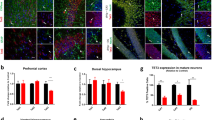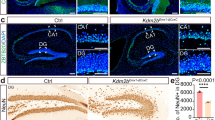Abstract
Hf-1b/Sp4, a member of the Sp1 family of transcription factors, is expressed restrictively in the developing nervous system and most abundantly in adult hippocampus in mice. Here, we report the generation of hypomorphic Sp4 allele mice, in which the Sp4 deficiency can be rescued by the expression of Cre recombinase. Vacuolization was detected in the hippocampal gray matter of the mutant Sp4-deficient mice. Expression analysis of Sp4 mutant hippocampi revealed an age-dependent decrease in neurotrophin-3 expression in the dentate granule cells. Hypomorphic Sp4 mutant mice displayed robust deficits in both sensorimotor gating and contextual memory. The restoration of Sp4 expression, via a Cre-dependent rescue strategy, completely rescued all the observed molecular, histological and behavioral abnormalities. Our studies thus reveal a novel Sp4 pathway that is essential for hippocampal integrity and modulates behavioral processes relevant to psychiatric disorders.
This is a preview of subscription content, access via your institution
Access options
Subscribe to this journal
Receive 12 print issues and online access
$259.00 per year
only $21.58 per issue
Buy this article
- Purchase on Springer Link
- Instant access to full article PDF
Prices may be subject to local taxes which are calculated during checkout








Similar content being viewed by others
References
Marin M, Karis A, Visser P, Grosveld F, Philipsen S . Transcription factor Sp1 is essential for early embryonic development but dispensable for cell growth and differentiation. Cell 1997; 89: 619–628.
Shahbazian M, Young J, Yuva-Paylor L, Spencer C, Antalffy B, Noebels J et al. Mice with truncated MeCP2 recapitulate many Rett syndrome features and display hyperacetylation of histone H3. Neuron 2002; 35: 243–254.
Dunah AW, Jeong H, Griffin A, Kim YM, Standaert DG, Hersch SM et al. Sp1 and TAFII130 transcriptional activity disrupted in early Huntington's disease. Science 2002; 296: 2238–2243.
Freiman RN, Tjian R . Neurodegeneration. A glutamine-rich trail leads to transcription factors. Science 2002; 296: 2149–2150.
Suske G . The Sp-family of transcription factors. Gene 1999; 238: 291–300.
Hagen G, Dennig J, Preiss A, Beato M, Suske G . Functional analyses of the transcription factor Sp4 reveal properties distinct from Sp1 and Sp3. J Biol Chem 1995; 270: 24989–24994.
Nguyen-Tran VT, Kubalak SW, Minamisawa S, Fiset C, Wollert KC, Brown AB et al. A novel genetic pathway for sudden cardiac death via defects in the transition between ventricular and conduction system cell lineages. Cell 2000; 102: 671–682.
Supp DM, Witte DP, Branford WW, Smith EP, Potter SS . Sp4, a member of the Sp1-family of zinc finger transcription factors, is required for normal murine growth, viability, and male fertility. Dev Biol 1996; 176: 284–299.
Gollner H, Bouwman P, Mangold M, Karis A, Braun H, Rohner I et al. Complex phenotype of mice homozygous for a null mutation in the Sp4 transcription factor gene. Genes Cells 2001; 6: 689–697.
Nakamura T, Lozano PR, Ikeda Y, Iwanaga Y, Hinek A, Minamisawa S et al. Fibulin-5/DANCE is essential for elastogenesis in vivo. Nature 2002; 415: 171–175.
Zhou X, Benson KF, Ashar HR, Chada K . Mutation responsible for the mouse pygmy phenotype in the developmentally regulated factor HMGI-C. Nature 1995; 376: 771–774.
Seress L, Gallyas F . The use of a sodium tungstate developer markedly improves the electron microscopic localization of zinc by the Timm method. J Neurosci Methods 2000; 100: 33–39.
Masliah E, Mallory M, Ge N, Alford M, Veinbergs I, Roses AD . Neurodegeneration in the central nervous system of apoE-deficient mice. Exp Neurol 1995; 136: 107–122.
Corbo JC, Deuel TA, Long JM, LaPorte P, Tsai E, Wynshaw-Boris A et al. Doublecortin is required in mice for lamination of the hippocampus but not the neocortex. J Neurosci 2002; 22: 7548–7557.
Mohn AR, Gainetdinov RR, Caron MG, Koller BH . Mice with reduced NMDA receptor expression display behaviors related to schizophrenia. Cell 1999; 98: 427–436.
Geyer MA, McIlwain KL, Paylor R . Mouse genetic models for prepulse inhibition: an early review. Mol Psychiatry 2002; 7: 1039–1053.
He L, Lu XY, Jolly AF, Eldridge AG, Watson SJ, Jackson PK et al. Spongiform degeneration in mahoganoid mutant mice. Science 2003; 299: 710–712.
Rizvi TA, Akunuru S, de Courten-Myers G, Switzer III RC, Nordlund ML, Ratner N . Region-specific astrogliosis in brains of mice heterozygous for mutations in the neurofibromatosis type 1 (Nf1) tumor suppressor. Brain Res 1999; 816: 111–123.
Vigers AJ, Baquet ZC, Jones KR . Expression of neurotrophin-3 in the mouse forebrain: insights from a targeted LacZ reporter. J Comp Neurol 2000; 416: 398–415.
Hassink GC, van Esseveldt KE, Dijkhuizen PA, Verhaagen J, Boer GJ . Ontogeny of neurotrophin receptor trkC expression in the rat forebrain and anterior hypothalamus with emphasis on the suprachiasmatic nucleus. Neuroscience 1999; 92: 705–712.
von Bohlen und Halbach O, Minichiello L, Unsicker K . Haploinsufficiency in trkB and/or trkC neurotrophin receptors causes structural alterations in the aged hippocampus and amygdala. Eur J Neurosci 2003; 18: 2319–2325.
Bates B, Rios M, Trumpp A, Chen C, Fan G, Bishop JM et al. Neurotrophin-3 is required for proper cerebellar development. Nat Neurosci 1999; 2: 115–117.
Braff DL, Geyer MA, Swerdlow NR . Human studies of prepulse inhibition of startle: normal subjects, patient groups, and pharmacological studies. Psychopharmacology (Berl) 2001; 156: 234–258.
Geyer MA, Krebs-Thomson K, Braff DL, Swerdlow NR . Pharmacological studies of prepulse inhibition models of sensorimotor gating deficits in schizophrenia: a decade in review. Psychopharmacology (Berl) 2001; 156: 117–154.
Swerdlow NR, Geyer MA, Braff DL . Neural circuit regulation of prepulse inhibition of startle in the rat: current knowledge and future challenges. Psychopharmacology (Berl) 2001; 156: 194–215.
Lipska BK, Jaskiw GE, Weinberger DR . Postpubertal emergence of hyperresponsiveness to stress and to amphetamine after neonatal excitotoxic hippocampal damage: a potential animal model of schizophrenia. Neuropsychopharmacology 1993; 9: 67–75.
Lipska BK, Swerdlow NR, Geyer MA, Jaskiw GE, Braff DL, Weinberger DR . Neonatal excitotoxic hippocampal damage in rats causes post-pubertal changes in prepulse inhibition of startle and its disruption by apomorphine. Psychopharmacology (Berl) 1995; 122: 35–43.
Geyer MA, Wilkinson LS, Humby T, Robbins TW . Isolation rearing of rats produces a deficit in prepulse inhibition of acoustic startle similar to that in schizophrenia. Biol Psychiatry 1993; 34: 361–372.
Varty GB, Marsden CA, Higgins GA . Reduced synaptophysin immunoreactivity in the dentate gyrus of prepulse inhibition-impaired isolation-reared rats. Brain Res 1999; 824: 197–203.
Harrison PJ, Eastwood SL . Neuropathological studies of synaptic connectivity in the hippocampal formation in schizophrenia. Hippocampus 2001; 11: 508–519.
Anderson JE, Wible CG, McCarley RW, Jakab M, Kasai K, Shenton ME . An MRI study of temporal lobe abnormalities and negative symptoms in chronic schizophrenia. Schizophr Res 2002; 58: 123–134.
Narr KL, van Erp TG, Cannon TD, Woods RP, Thompson PM, Jang S et al. A twin study of genetic contributions to hippocampal morphology in schizophrenia. Neurobiol Dis 2002; 11: 83–95.
Seidman LJ, Faraone SV, Goldstein JM, Kremen WS, Horton NJ, Makris N et al. Left hippocampal volume as a vulnerability indicator for schizophrenia: a magnetic resonance imaging morphometric study of nonpsychotic first-degree relatives. Arch Gen Psychiatry 2002; 59: 839–849.
Schulze K, McDonald C, Frangou S, Sham P, Grech A, Toulopoulou T et al. Hippocampal volume in familial and nonfamilial schizophrenic probands and their unaffected relatives. Biol Psychiatry 2003; 53: 562–570.
Acknowledgements
We thank Dr Eric Turner for his critical reading of an earlier draft, and Jacob Ong for his helpful comments on the manuscript. Julie Anderson and Kim Weldy provided excellent maintenance of the mouse colony. These studies were supported by NIH funding to KC, the Veterans Affairs VISN 22 Mental Illness Research, Education, and Clinical Center and a grant from the National Institute of Mental Health MH42228 (MG). XZ was supported by NIH training grant. MA Geyer holds an equity interest in San Diego Instruments.
Author information
Authors and Affiliations
Corresponding authors
Additional information
Supplementary Information accompanies the paper on Molecular Psychiatry website (http://www.nature.com/mp).
Supplementary information
Rights and permissions
About this article
Cite this article
Zhou, X., Long, J., Geyer, M. et al. Reduced expression of the Sp4 gene in mice causes deficits in sensorimotor gating and memory associated with hippocampal vacuolization. Mol Psychiatry 10, 393–406 (2005). https://doi.org/10.1038/sj.mp.4001621
Received:
Revised:
Accepted:
Published:
Issue Date:
DOI: https://doi.org/10.1038/sj.mp.4001621
Keywords
This article is cited by
-
Analysis of the Relationship between Genetic Factors and the Risk of Schizophrenia
Neuroscience and Behavioral Physiology (2023)
-
Over-representation of potential SP4 target genes within schizophrenia-risk genes
Molecular Psychiatry (2022)
-
Resolving heterogeneity in schizophrenia through a novel systems approach to brain structure: individualized structural covariance network analysis
Molecular Psychiatry (2021)
-
Mechanisms regulating dendritic arbor patterning
Cellular and Molecular Life Sciences (2017)
-
FUS/TLS deficiency causes behavioral and pathological abnormalities distinct from amyotrophic lateral sclerosis
Acta Neuropathologica Communications (2015)



